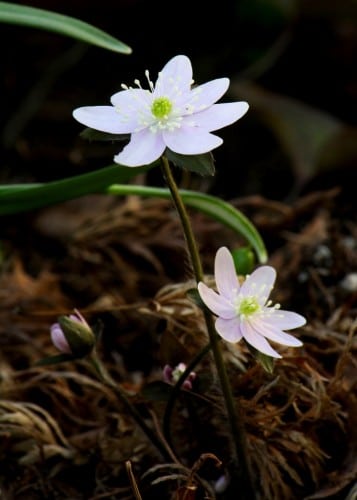What a week! The warm days have brought out flowering shrubs, and the garden is flooded with displays of yellow forsythia and Cornelian cherry (Cornus mas), pink arrowwood viburnums ‘Dawn’ and ‘Charles Lamont’ (Viburnum x bodnantense), and purple and white February daphne (Daphne mezereum). It’s too much happiness, all at once. Fortunately, temperatures are now more seasonal and that will help the plants hold their blooms for a while.

Despite having a spectacle of flowering shrubs, I still look for the little cluster of sharp-leaf hepatica (Hepatica acutiloba, Zone 4) that blooms in a shady corner. These sweet little flowers are sometimes called spring beauty, and that seems a perfect name for their bright daisy-like faces with prominent anthers. Their feathery buds rise from a cluster of semi-evergreen foliage and turn pink or blue while still folded, then open to a paler colour that fades into white. If temperature remains cool, the flowers will last a month, and then the glossy foliage is attractive all summer. The three-lobed, fused leaves have thick substance, with fine hairs on the undersides. They serve to nurture the plant in all seasons (including winter), so don’t tidy them up until new foliage appears in late spring.
But not all is sweetness and light in my garden. Neighbouring construction for the past two summers has prevented the usual maintenance tasks in the back, and now I regret not starting the cleanup last autumn. Almost everything is growing, and removing dead leaves and stalks can easily injure newly emerging stems. This leads me to the challenging discovery of many sapling trees that have taken root in the beds. I can well understand how forests carpet a continent. I’ve found dozens of waist-high saplings of redbud, white ash, birch and chokecherry, and smaller seedlings of yew and juniper. I intend to leave the evergreen seedlings, but the others must go. They’ve taken tenacious hold wherever leaf mulch was absent, their seeds falling on bare ground and rooting. Many have found footing at the edge of the beds, and then sent their roots under the adjacent lawn where soil is moist and cool. And how they hang on! This is the kind of work that breaks shovel handles. Trying to follow and remove their roots has created several ditches in the lawn, and those will need to be repaired. This is a hard, but true lesson—wherever soil is bare, tree seeds will flourish. Mulch, mulch, mulch!
Judith’s post last week:









Hi Sharon,
My hepatica clumps are slow to thicken, and I don’t see any seedlings… But we live in hope. That early warmth has certainly pushed plants along a bit too quickly. We’re expecting snow tonight!
— Judith
Hepatica, I love ’em! I have a small clump I brought from my grandfather’s farm in Quebec, and mine are out too, in the Ottawa area, due to the early hot spell we had.